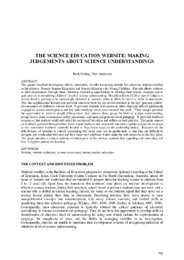| dc.contributor.author | Hickey, Ruth | en |
| dc.contributor.author | Anderson, Neil | en |
| dc.coverage.spatial | CY - Λευκωσία | en |
| dc.coverage.spatial | Learning in Physics Group, University of Cyprus | en |
| dc.creator | Hickey, Ruth | en |
| dc.creator | Anderson, Neil | en |
| dc.date.accessioned | 2016-02-19T06:44:01Z | |
| dc.date.available | 2016-02-19T06:44:01Z | |
| dc.date.issued | 2003 | |
| dc.identifier.uri | http://hdl.handle.net/10797/14736 | en |
| dc.description | Περιέχει το πλήρες κείμενο | el |
| dc.description.abstract | This project involved developing a lively, interactive, visually interesting website for university students enrolled in the subjects: Primary Science Education and Science Education for Young Children. This site allows students to view experiments through video, therefore expanding opportunities to develop their science concepts and to gain practice in identifying children’s level of science understanding. Flexible delivery of all or part of subjects at tertiary level is proving to be increasingly attractive to students, often to allow for work or home commitments. This site supplemented lectures and provided intensive work for pre-service teachers in the key ‘graduate quality’ of assessment of children’s science work. It provided students with access to video clips and stills of participants engaged in science investigations and key understandings about assessment of this work. These images provided the opportunity to: observe people talking about their science ideas, gauge the level of science understanding,
design lesson plans, comment on safety procedures, and make judgements about pedagogy. It provided feedback systems so that students could self-select for revision of key ideas and reflect on their practice. This paper reports on feedback gathered through online forms, email feedback and structured interviews and documents the response to this innovative initiative currently located at http://www.maps.jcu.edu.au/develop/hickey. Research on the effectiveness of websites is critical considering that some sites can be problematic in that they are difficult to navigate, are overloaded with text and lack those very attributes which make the web attractive in the first place. This paper provides a critical analysis of which parts of this website students find appealing and interesting and how it supports productive learning. | en |
| dc.language.iso | eng | en |
| dc.publisher | Department of Educational Sciences, University of Cyprus | en |
| dc.relation.ispartof | Learning and teaching | en |
| dc.rights | info:eu-repo/semantics/openAccess | en |
| dc.rights | Open Access | en |
| dc.source | CBLIS Conference Proceedings 2003 Volume I: New Technologies and their applications in education | en |
| dc.title | The science education website: making Judgements about science understandings | en |
| dc.type | info:eu-repo/semantics/conferenceObject | en |
| dc.subject.uncontrolledterm | Website | en |
| dc.subject.uncontrolledterm | Website evaluation | en |
| dc.subject.uncontrolledterm | Science assessment | en |
| dc.subject.uncontrolledterm | Tertiary teacher education | en |
| dc.contributor.coordinator | Constantinou, Constantinos P. | en |
